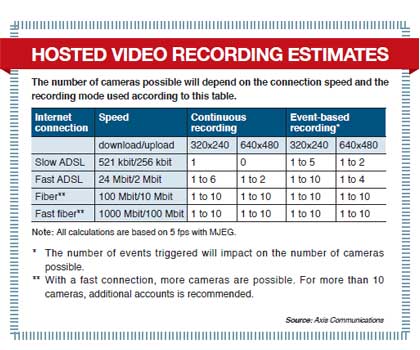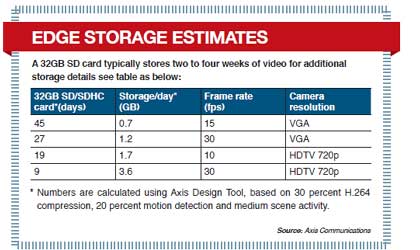Storage is an integral part of any video surveillance system. It is also typically the most expensive component. However, knowing the best method of storage to meet end-user and regulatory requirements would greatly reduce costs and enhance reliability.
With more options, selection of the best storage method to suit specific needs and situations becomes more complex. “Previously, technology revolved around reducing the quality of the recorded video or the frequency with which video frames are recorded on the storage media. In recent years, however, the advent of and attraction to higher resolution cameras, combined with regulations that require extended retention periods of high-resolution, real-time footage, have made these practices useless and obsolete,” said John Minasyan, Senior Product Manager of IP Video Management Systems at Pelco by Schneider Electric. “More than ever, the industry today is faced with finding a cost-effective, highly reliable, scalable storage architecture to satisfy end-user and regulatory agency requirements.”
STORAGE REQUIREMENTS
The choice of storage typically depends on the size of business, the investment model, and the storage needs. Most importantly, security systems must be scalable, flexible, and able to adapt to a company's changing protection needs. Considerations should factor in bandwidth and system requirements and whether the system is capable of delivering the demands. Typically, installations deploy one method or a combination of methods for storage.
Government regulations, industry standards or internal best practice often set requirements regarding recorded video. “The storage time and the amount of recorded data determine what storage solution is required, not to mention that different markets have different requirements. For example, it is common for retailers in certain regions to save recordings for 30 days,” mentioned Jarmo Kalliomaki, Product Manager at Axis Communications.
Regulations vary between states within the U.S. and between countries. “The backlog in criminal cases in California courts mandate that video evidence be archived for 365 days. In gaming applications in the state of Nevada, video footage for all gaming cameras have to be captured at 30 images per second at a minimum of 4 CIF resolution for seven days. In France, recently enacted public safety laws required 4 CIF resolution, real-time video for all public safety and city surveillance applications,” echoed Minasyan.
 LARGE-SCALE INSTALLATIONS
LARGE-SCALE INSTALLATIONS
NVRs are the go-to default storage option in the megapixel camera world. In addition, larger-scale projects prefer centralized management and storage of video and recorded data.
There are a number of challenges in large-scale surveillance deployments. From a storage perspective, according to IDC, these include managing multiple, long streams of content, ensuring that enough storage is installed (or can be installed) so that video streams can be recorded continuously without interruption, and ensuring the quality of video stream. If a storage system cannot keep up, frames will be dropped.
Large-scale installations, such as airports, governments, enterprises, and critical infrastructure will opt for PC-based storage or server-based storage. Such verticals require superior computing power, along with high security. PC-based storage or serverbased storage offers more reliability and stability on this front.
Storage capabilities depend on the scale of the security system in question. For example, a 100-camera system with seven days of storage, recording at 24 hours per day at 15 images per second, using MJPEG compression could require more than 30TB of storage. Consequently, “a solution that will store large amounts of data for a long period, typical in a government segment, should consider centralized solutions like NVRs or server-based storage,” mentioned Kalliomaki.
COMPLEMENTING CENTRALIZED STORAGE
For large organizations, failover solutions are increasingly required. In these situations, edge storage is often deployed and work as a complement to central storage, recording video locally when the central system is not available for any reason. Alternatively, the end user may prefer to deploy edge recording simultaneously with the central system so that missing video clips caused by network disruptions or central system are not lost. The images are, instead, recorded by the camera, retrieved at a later time, and merged with the central storage.
Hence, "today we do not see edge storage as a solution for primary storage in enterprise deployments. However, we do see a fit for edge storage as a way of adding redundancy to your deployment," echoed Tom Larson, Director of Global Accounts at BCDVideo.
When integrated with a central storage system, edge storage increases the comprehensiveness of the video surveillance system for mission-critical installations, remote locations, and mobile situations. For example, edge storage can improve video analysis for systems with low network bandwidth where video cannot be streamed at the highest quality.
“Edge and centralized storage can, and do, actually complement each other in many situations. Edge storage provides an excellent ‘buffer' in the connectivity of a camera that would be otherwise considered unreliable,” explained George Scholhamer, VP of Sales Engineering at Pivot3. “Take for instance a shipping lane, with wireless cameras located along the waterway. Weather can frequently interfere with communication between the camera and the SoC, and edge storage can ensure that while transmission may be interrupted, actual video will not be lost during the disturbance. As cameras are frequently being pushed to the edges of facilities, the quality of the link will suffer.”
While cloud storage may not be ideal for mission-critical locations, some governments have adopted it to complement and enhance their current surveillance systems. For example, the county of Taoyuan is home to Taiwan's main international airport and serves as the international air hub of Taiwan. Traffic monitoring on the roads is enhanced with cloud-based intelligence, allowing police forces to identify and track suspicious vehicles across multiple cameras in real time.
Accordingly, MarketsandMarkets reported key verticals for VSaaS are commercial, institutional, residential, industrial, and infrastructure.
MULTI-SITE BUSINESSES
Multi-site businesses benefit with PC-based NVRs, server-based storage, and cloud storage. “Geographically dispersed organizations can greatly benefit from NVRs. The only way these businesses have survived and thrived is by deploying cutting-edge wide area networks (for general business needs), and the video surveillance and security system should be able to ride on the same infrastructure,” said Mike Scirica, VP of Marketing and Sales at WavestoreUSA.
Cloud storage is especially suitable for multi-site businesses that would like the ability to monitor all their stores at once. Also, if there are issues with the system, IT personnel do not have to waste time travelling between stores. For example, in many emerging countries such as Mexico, travelling from business location to location within cities can take hours. Heavily populated areas in Latin America create heavy traffic congestions, burdening productivity with lengthy and unavoidable traffic jams. Cloud storage can relieve this burden and increase overall operational efficiencies.
EDGE AND CLOUD STORAGE SHINE IN RESIDENTIAL AND SMALL BUSINESS SECTORS
 Residential and small businesses have security needs too, but they are more riddled with budget concerns and may require less complex storage methods.
Residential and small businesses have security needs too, but they are more riddled with budget concerns and may require less complex storage methods.
Edge storage would appeal to residential and small businesses. “Edge storage offers the easiest scalable video surveillance solution for small systems up to 16 cameras,” said Kalliomaki. Currently, as memory cards of 64 to 128GB give the most efficient storage in solutions up to four cameras.
“Typically, we are seeing smaller companies deploying edge as a fairly low-cost method of storage while it provides a failsafe measure in medium to large applications,” said Brian Song, MD of IDIS Europe.
Cloud storage is perfect for smaller businesses and chain stores because it is highly suitable for up to 10 cameras per site. Some vendors, for example, offer hosted service solutions that provide features to improve retail business operations such as drive-through promotions, daily deliveries, cash protection, guest verification, and third party services including POS, manpower distribution and remote handling of package delivery. Hence, hosted service is offering more than just surveillance on the cloud, and this is one of the drivers of its uptake.
The selection of storage options on the market today offers so much more to end users. Remote storage in the cloud is becoming more affordable and edge devices are more intelligent.